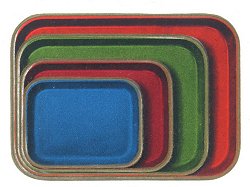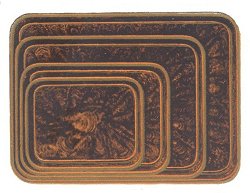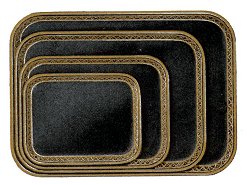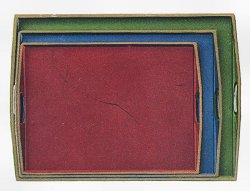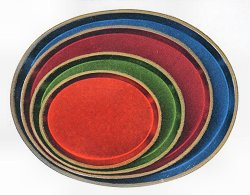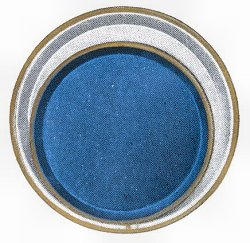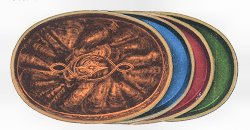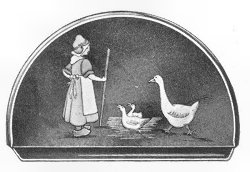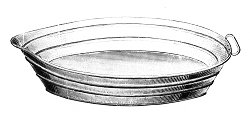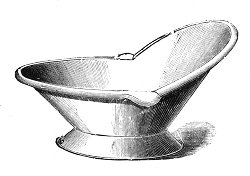General Metal and Holloware
 |
Orme Evans & Co. Ltd.
Elgin Works, Great Brickkiln Street
|
 |
The 1927 catalogue (continued)
At this point in the catalogue there is a sudden burst of colour.
The items which merit this special treatment are Japanned Trays.
All of these trays are said to be hand polished and the
gold edges are printed in the catalogue using some sort of metallic ink.
But even this does not disguise the fact that these are but sorry
hangovers of the once splendid and elaborate japanning work which was
carried out in Wolverhampton. Hand polished or not, this was mass
production. All of these designs of tray (and the ones on the
right are said to be "Pollard Oak") come in size from 12 inches to 26
inches, in two inch increments.
The trays on the left are said to have a "Metal Border".
One has a feeling that, had it been real gold leaf, they would have said
so. Nevertheless the black and gold brings them nearer to the old
style than any of the others. The ugly trays to the right are
called "Carlton" and are said the be "Registered". Presumably this
means a registered design. I can't think why they bothered.
The oval trays are called "Elgin". The round ones on
the right are not trays at all, but "waiters" and they came in many
colours but only in two small sizes, 10 and 12 inches; there
were also oval waiters, (shown below) which were only available at
15inches wide. The only dictionary definition I can find suggests
that waiters were smaller trays but I get the impression from this and
other catalogues that a waiter was used for carrying things to unload on
the table (and was then taken away) and a tray was put down on the table
and left there.
The Japanned Child's trays are shown in black and white
only, which, in view of the three designs available, (we exhibit the
least tacky), is probably just as well. But "The inverted rim
prevents the milk or other liquid, which the child may upset, from
soiling the table-cloth, and the trough along the front edge saves
Baby's clothes and the carpet".
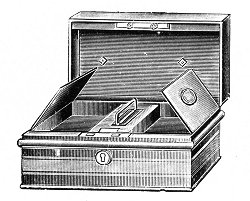 |
Whilst on the subject of the decline of japanning, here is
a cash box - one of three types available, as well as two types of deed
box. This cash box came in five sizes, up to 12 inches, and could
have one of 4 different locks fitted. Cash boxes went out of use
as more cash registers and tills came into use but they hung around in
many people's houses for many years, and were amongst the last of the
japanned goods to be regularly made, typically in black with gold and
red lining. |
We turn now to the more prosaic world of the larder.
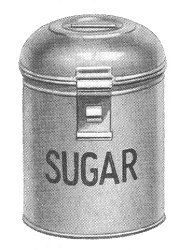 |
The canisters on the left were available for 2lb or
3 lbs and with assorted lettering. But the flour box on the
right was available for 1/2, 3/4 or 1 stone of flour.
The
flour box was not available with other lettering as flour was the
only item which would be kept in such large quantities. |
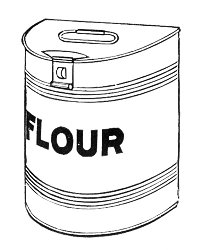 |
| Spices, of course, came in much smaller quantities.
This spice rack comes in assorted colours but only with the lettering
for cinnamon, allspice, mace, nutmeg, cloves and ginger. The thing
on the right of the rack is probably a nutmeg grater. |
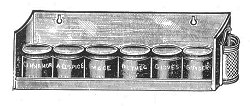 |
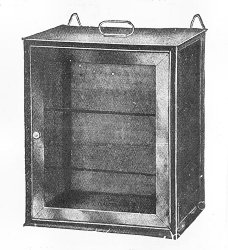 |
In the days before refrigerators were at all
widespread, one would need the meat safe on the left. On
the right are cake cabinets, available in assorted colours,
including grained oak, and all with white enamelled shelves. |
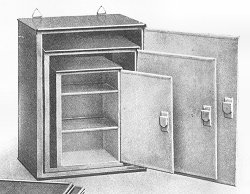 |
The remarkable thing about the cake cabinets were that
they were all fitted with a lock. Who were you trying to keep out?
The maid? Your overweight husband?
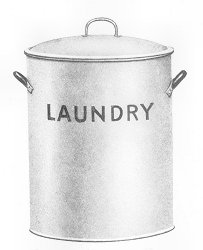 |
We are now in the scullery, wash house or brew
house. You would put your used items in the laundry bin until
the water was heated in the copper and the whole, horrible,
rigmarole of washday had come round again.
And, of course, you would
need something like the "Dinkum Housemaid's Pail", to make life a
little easier for your servants. |
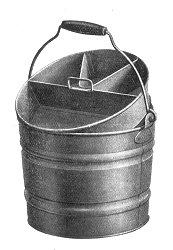 |
If all of this is getting a bit much, you might feel
inclined to relax in a nice hot bath:
Orme's did not make the galvanised wash tubs which
traditionally hung on the wall of the back yard but they did offer the
sponge bath on the left, which was either 33 or 36 inches wide. It
still had a handle for hanging it up. On the right is an Oxford
Hip Bath, an altogether more dignified affair, suitable for use in the
bedroom, wither the maid would bring the hot water in one of the hot
water pails we have already seen Orme's providing.
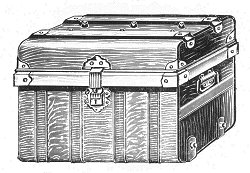 |
But if you are really fed up with living in the 1920s
household, you could pack your Scarborough or your Dover steel
travelling trunk and go on holiday.
This is the Dover. When you had packed it, it would
be usual to send it to your hotel, a few days in advance, by railway.
Nothing was simple in those days. |
|

|

|
|
Return to
the beginning |
Return to the
list of companies |
|


